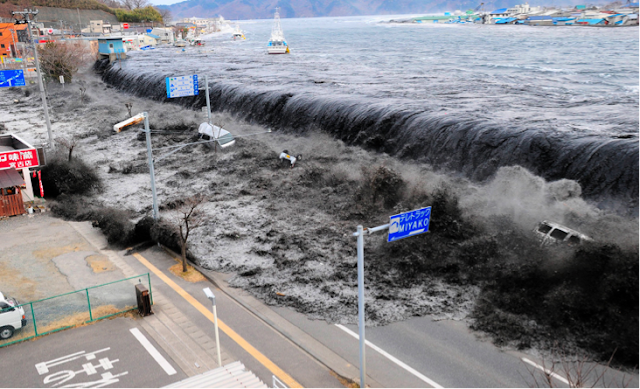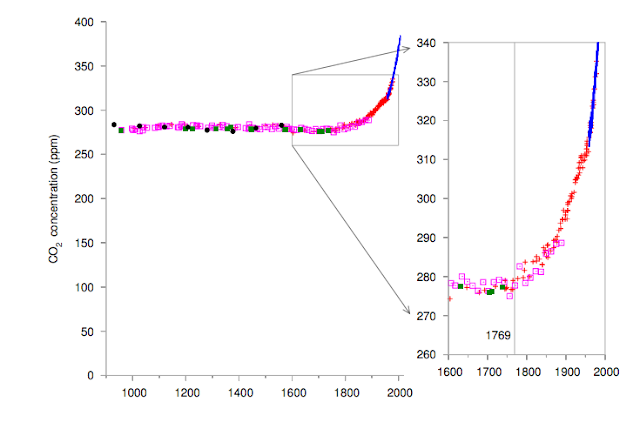In my fourth blog assessing the viability of living without nuclear energy, I came to the conclusion that it would be unwise to scrap nuclear power altogether. If the climate models are right, we risk environmental, economic and societal cataclysm should we choose a 'business as usual' strategy. Action is needed fast and I felt the yield available from nuclear power per kilogram and per acre would be highly valuable. Especially in areas where renewable alternatives are a long way off.
 |
| Last week the Japanese government blaming its shuttered nuclear industry slashed its 2020 GHG emissions target to a 3.8% drop versus 2005 levels, this amounts to a 3 % rise from the UN benchmark year of 1990 and a reversal of the previous target of a 25% reduction, could this be commonplace if there is an exodus away from Nuclear power? Source: Huffington Post, 2013 |
However after last week’s blog whilst I agree with all of the above I can’t help but recognise the inherent risk of nuclear power. Yes, events like Chernobyl and Fukushima could be termed accidents triggered by human error and 'uncontrollable' natural events. However once the flame was lit, the proceeding fire bore the characteristics of a recalcitrant technology eliciting a cascade of further problems (Pritchard, 2012).
How might industry officials and supporters of nuclear power respond to this claim and justify increased investment in nuclear energy moving through the 21st century?
Many would argue that nuclear energy does ultimately have a good safety record. According to Sailor (et al 2007) outside of the Soviet union about 8500 reactor years of commercial nuclear power plant operation had been realised up to the year 2000 without any large external release of radioactivity, and only one accident with fuel melting (i.e. Three Mile Island in 1979). From this Sailor (et al, 2007) averaged the risk of an accident involving fuel damage as 1 in 10000 reactor years based on Generation II reactors. At face value this seems reasonable, but let's say we turn to nuclear power to curve emissions, and by 2050 it is responsible for a 1/3 of global electricity demand. This would require up to 4000 plants and the expectation would be for an accident involving fuel damage every several years!
This figure is shocking, but it is derived from a past average over a period where safety likely improved considerably. In fact by analysing data on the occurrence of individual system malfunctions (precursor events) it has been estimated that the probability of core damage fell by a factor of roughly 100 when comparing the 1994-1998 record to 1974-1978 alone. Generation III reactors developed in the late nineties and coming into fruition now, promise even greater safety.
 |
| Schematic of an Advanced boiling water reactor, these Generation III reactors have been estimated to have a probability of core damage as low as 2x10^-7 per reactor year, or one accident in every two hundred million years running Source: Mowry, 2000 |
The above figures are impressive but what about when we bring seismic activity into the equation, what does the nuclear industry do to reduce the risk it poses?
In the USA, the largest consumer of nuclear energy, even plants that are located outside areas with extensive seismic activity are designed for safety in the event of a natural disaster. They take the most severe natural phenomena historically reported for the site and surrounding area, and then add a margin for error to account for limited historical accuracy. They consider soil structure around the site and the resonance frequencies of a wide range of structures to reduce risk further. When new hazard information becomes available, the NRC evaluates the new data and models and determines if any changes are needed at plants, so in theory plants are constantly evolving.
 |
| Map showing the location of Nuclear power plants, given the areal extent of the US, for the most part areas of high seismic activity are avoided, the situation likely differs in Japan Source:NRC, 2012 |
The design flaws at Fukushima however weren't in reactor design, rather in the supporting infrastructure and flood defences surrounding the site. If Fukushima did one thing it flagged up the need to consider all components of the site. At Hinkley Point C for example construction director Nigel Cann (HazardEx, 2013) summarises that the primary modifications post-Fukushima were in elevating power supplies above ground level and building flood defences to withstand a 0.2% AEP event (equivalent to a 500 year flood event) (EDF,2011). The importance of passive features such as hydrogen recombiners which turn hydrogen into inert gas thus avoiding explosions were also highlighted (HazardEx, 2013).
"One of the main things we learned from Fukushima was the need for hardened facilities which hasn't been a priority at UK nuclear stations up until now and to ensure we have secure control and safeguard buildings if there is an incident" Nigel Cann
Taking into account the increasing safety
and efficiency of modern reactors along with the promise of a more holistic
approach to hazard assessment, investment in nuclear power is certainly looking
more attractive. However greater safety means greater cost, and I fear that regulatory
standards could drop with acceleration in plant construction. Hypothetically if standards were upheld I would advocate plant construction in areas of limited seismic activity, despite its inherent risk.
Thanks for reading!







